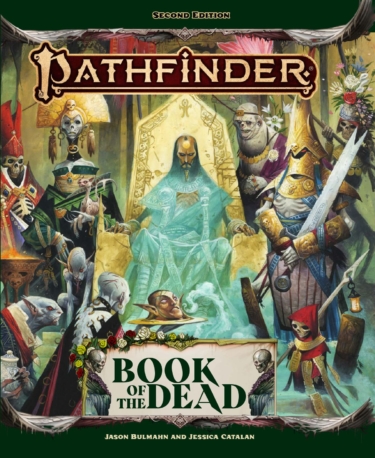
Publisher: Paizo Inc
Authors: Jason Bulmahn, Jessica Catalan, Brian Bauman, Tineke Bolleman, Logan Bonner, John Compton, Chris Eng, Logan Harper, Michelle Jones, Jason Keeley, Luis Loza, Ron Lundeen, Liane Merciel, Patchen Mortimer, Quinn Murphy, Jessica Redekop, Mikhail Rekun, Solomon St. John, Michael Sayre, Mark Seifter, Sen H.H.S., Kendra Leigh Speedling, Jason Tondro, and Andrew White
Artists: Wayne Reynolds, Shafi Adams, Jason Artuz, Helge C. Balzer, Tuan Duong Chu, Josh Durham, Wilmar Ballespí Escarp, João Fiuza, Kent Hamilton, Dariusz Kieliszek, Mayra Luna, Damien Mammoliti, Artur Nakhodkin, Vladislav Orlowski, Mirco Paganessi, Roberto Pitturru, Sandra Posada, Kiki Moch Rizky, Roena Rosenberger, Luis Salas Lastra, Olli Slyusareva, Firat Solhan, Carl Springer, and Iana Vengerova
Year: 2022
Genre: Pathfinder roleplaying game supplement
Pages: 224 pages
MSRP: $49.99 in softcover or $14.99 in PDF
Pathfinder opens the crypt door into a deep dive on necromancy with Book of the Dead, providing GMs and players with a treasure trove of new lore and mechanics.
Book of the Dead alternates between in-universe sections written by Geb, King of the Great Nation of Geb, and out-of-universe mechanics. This helps to keep information that directly impacts character creation or play handy while still giving the in-universe writing room to breathe.
Which isn’t to say those in-universe sections don’t impact gameplay! Book of the Dead is laden with details to be worked into adventures, campaigns, and encounters. Need to have your characters discover that the village’s new undertaker may not be what they appear? Have them discover a chunk of text and read to them some of Geb’s writing. Need to explain why one kind of magic weapon works in one situation, but not in another seemingly similar one? As long as it has to do with the undead, Geb has you covered.
The additions to Pathfinder’s mechanics are substantial, including new backgrounds, archetypes, items, enemies and allies. Possibly the most intriguing section is on playing undead characters. Whether you’re interested in playing a ghost, ghoul, lich, mummy, skeleton, vampire, or zombie, Book of the Dead has you covered. It’s a fresh take that opens the door to all manner of interesting storytelling possibilities. Even in this mechanical section, a fair bit of humor seeps in with abilities like “Brains!” and “Ankle Biter” working their way in with their less colorfully named counterparts.
The book also includes advice on telling ghost stories within the Pathfinder framework. For anyone who has ever been interested at trying their hand, Book of the Dead offers an actionable framework, highlighting the key players and story structure. The book also includes a generous list of haunts, providing GMs with a robust library to help bring on the scares.
Book of the Dead benefits from some of the best art to grace a Pathfinder text since the Strength of Thousands Adventure Path. Rather than taking on the typical colors of death and decay, the art instead relies on cream, bronze, and an almost peach, calling to mind headstones, memorials, and formerly rosy cheeks. The imagery plays on this theme as well with somber statues bedecked in floral wreaths, swags for mourning, candles, and even an eternal flame — along with a practically obligatory skull. It’s a
The individual page and accent art is likewise delightful. One particular standout piece of an Undead Eidolon with a stick horse, though the loyal Old Friend was a close second. There’s often a sense of whimsy to these pieces, highlighting the broader view of necromancy and its practitioners that Book of the Dead offers.
The only challenge comes in when it comes time to decipher Geb’s handwriting. While the presence of these handwritten sections certainly does lend an air of personality and authenticity to the visual design, Geb tragically suffers from penmanship that is somewhat difficult to scan at a glance. While this is probably very much in spirit for the character, it’s a small hindrance for the average reader.
Book of the Dead is a delight. For Pathfinder fans who enjoy their lore with a hefty dose of in-universe flavor and paired with mechanical additions that feel fresh and exciting, this is a must-have. Supported by clever visual design and surprisingly whimsical art, the book is a joy to read and a wonderful addition to any Pathfinder library.